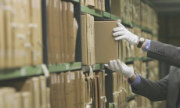


Reanalysis
(Needs editorial input)
Weather Hindcasting - Using models to look backwards
ACRE
and
its
partners
undertake
the
recovery
and
digitisation
of
historical
surface
terrestrial
and
marine
weather
data
from
around
the
globe.
The
data
they
rescue
is
stored
in
international
databanks
which
are
used
by
a
host
of
climate
reanalysis
systems
which
estimate
past
weather
activity.
Generally
speaking,
climate
reanalysis
systems
take
the
concepts
of
weather
forecasting
models
and
reverses
them
to
do
look
backwards
instead
of
forwards.
This
weather
‘backcasting’
recreates
what
past
weather
probably
looked
like.
(
http://mc-stan.org/manual.html,
p.57
).
A
more
nuanced
description
of
the difference between climate models and weather forecasting models can be found
here
.
Products of Reanalysis Systems
ACRE
data
are
described
as
“observational”
as
it
originates
from
human
or
machine-recorded
observations
of
weather
instruments
such
as
thermometers,
barometers,
anemometers,
etc.
Using
limited
sets
of
these
observational
data
as
a
starting
point,
climate
reanalysis
systems
simulate
the
full
array
of
the
Earth’s
weather
patterns.
They
do
this
over
several
decades
or
longer,
and
can
cover
the
entire
globe
from
the
Earth’s
surface
to
well
above
the
stratosphere.
By
calculating
the
overall
historical
state
of
the
climate,
they
generate
estimates
of
many
more
weather
variables
beyond
the
original
limited
set
of
observational
data
assimilated
by
them.
These
interpolated
variables,
or
reanalysis
“products”,
can
cover
50
or
more
weather
conditions
including
atmospheric
temperature,
pressure,
wind
and
humidity
at
different
altitudes,
surface
rainfall
and
soil
moisture
content,
and
even
ocean-surface
temperature
and
salinity.
They
also
create
an
array
of
derived
variables,
such
as
fluxes.
Thus,
limited
historical
observations
are
used
to
create
a
much
richer
perspective
of
our
climate
heritage.
With
this
perspective,
climate
scientists
use
reanalysis
products
to
assess
climate
variability
over
a
long
period
of
time,
so
gaining
an
insight
into
how
it
may
be
changing.
Specific
outputs
from
the
systems
are
also
useful
in
other
fields
of
study
including
ecology
(climate
impact
on
species),
commercial
risk
analysis
(insuring
for
storm/flood
damage)
and
the
social
sciences
(human
reactions
to
climate
extremes).
See
here
for
a
more
comprehensive
review
of
how
reanalyses
products
are
used.
(URL)
Differences Between Systems
Reanalysis
systems
can
be
distinguished
by
the
geographical
span,
temporal
coverage
and
individual
characteristics
of
their
output
products.
Most
systems
have
a
global
reach,
they
cover
at
least
the
last
30-50
years
of
weather
and
they
generally
produce
50+
estimates
covering
ground,
air
and
water
weather
products.
An
important
feature
is
the
level
of
accuracy
in
each
of
the
products,
considering
that
they
have
been
interpolated
from
a
narrow
base
of
observational
data.
Some
models
claim
to
have the same accuracy as current three day weather forecasts.
Those
systems
focussed
on
reanalyses
after
1940s-50s
generally
use
large
amounts
of
automatically
recorded
data
by
radiosondes,
ocean
buoys,
automatic
ground
weather
stations,
etc.
These
late
20th
Century
devices
have
automated
data-logging
capabilities
that
generated
a
very
rich
set
of
observational
weather
data.
However,
before
the
1940s-50s,
weather
observations
are
generally
only
available
from
physical
recording
media
like
paper.
Some
of
the
observations
were
made
by
machines
onto
paper
while
others
were
recorded
by
humans,
resulting
in
far
less
data
being
available
for
reanalysis.
What
data
does
exist
(and
has
been
discovered)
has
to
be
digitised
before
it
can
be
assimilated
into
the
computer
models.
This
is
done
either
by
humans
or
by
character
recognition
software,
both
laborious
processes
resulting
in
a
further
reduction
in
available
data.
Addressing
this
deficiency is one of ACRE’s core activities.


“Consolidating the paper
record presents a major
challenge…”
“ACRE coordinates many
projects around the globe
that under-take data
rescue…”











